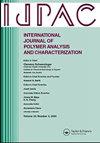Effect of sodium chloride and water-soluble polymers on thermochromic properties of hydroxypropyl cellulose solution
IF 1.7
4区 工程技术
Q4 POLYMER SCIENCE
International Journal of Polymer Analysis and Characterization
Pub Date : 2024-12-10
DOI:10.1080/1023666X.2024.2435853
引用次数: 0
Abstract
Hydroxypropyl cellulose (HPC) and its rather low lower-critical-solution-temperature (LCST) were the main research targets in many recent publications. In this study, a simple and affordable approach to measure LCST using a Brookfield viscometer was presented. The setup using a popular hot plate and a silicone oil bath could well detect the HPC solution’s LCST values. The result was in good agreement with the particle size change obtained using the dynamic light scattering technique. The effect of polyacrylic acid (PAA) and other cellulose derivatives including hydroxypropyl methylcellulose (HPMC), hydroxyethyl cellulose (HEC), or sodium carboxymethyl cellulose (CMC) on HPC’s LCST was investigated. The mixture of HPC with PAA, HPMC, and CMC showed the lowest LCST. However, the effect of NaCl seemed to be stronger when the LCST value of only 28.5 °C was obtained with 1 wt% of HPC and 5 wt% of NaCl. Fourier-transformed infrared spectroscopy results also showed a stronger interaction of HPC/NaCl compared to the mixture with PAA of HPMC. The differential scanning calorimetry only detected the signal change correlated with LCST in the cooling cycle. The glass window fabricated with the current thermochromic solution was able to block and transmit visible light well at low and elevated temperatures, respectively.
氯化钠和水溶性聚合物对羟丙基纤维素溶液热致变色性能的影响
羟丙基纤维素(HPC)及其较低的低临界溶液温度(LCST)是近年来许多出版物的主要研究对象。在这项研究中,一个简单的和负担得起的方法来测量LCST使用布鲁克菲尔德粘度计提出。使用流行的热板和硅油浴的设置可以很好地检测HPC溶液的LCST值。结果与动态光散射技术得到的颗粒尺寸变化结果吻合较好。研究了聚丙烯酸(PAA)和羟丙基甲基纤维素(HPMC)、羟乙基纤维素(HEC)、羧甲基纤维素钠(CMC)等纤维素衍生物对HPC的LCST的影响。HPC与PAA、HPMC和CMC混合的LCST最低。然而,当HPC添加量为1 wt%, NaCl添加量为5 wt%时,LCST值仅为28.5°C, NaCl的作用似乎更强。傅里叶变换红外光谱结果也表明,与HPMC的PAA混合物相比,HPC/NaCl的相互作用更强。差示扫描量热法仅检测冷却周期中与LCST相关的信号变化。用当前的热致变色溶液制作的玻璃窗在低温和高温下分别能够很好地阻挡和透射可见光。
本文章由计算机程序翻译,如有差异,请以英文原文为准。
求助全文
约1分钟内获得全文
求助全文
来源期刊
CiteScore
3.50
自引率
5.30%
发文量
37
审稿时长
1.6 months
期刊介绍:
The scope of the journal is to publish original contributions and reviews on studies, methodologies, instrumentation, and applications involving the analysis and characterization of polymers and polymeric-based materials, including synthetic polymers, blends, composites, fibers, coatings, supramolecular structures, polysaccharides, and biopolymers. The Journal will accept papers and review articles on the following topics and research areas involving fundamental and applied studies of polymer analysis and characterization:
Characterization and analysis of new and existing polymers and polymeric-based materials.
Design and evaluation of analytical instrumentation and physical testing equipment.
Determination of molecular weight, size, conformation, branching, cross-linking, chemical structure, and sequence distribution.
Using separation, spectroscopic, and scattering techniques.
Surface characterization of polymeric materials.
Measurement of solution and bulk properties and behavior of polymers.
Studies involving structure-property-processing relationships, and polymer aging.
Analysis of oligomeric materials.
Analysis of polymer additives and decomposition products.

 求助内容:
求助内容: 应助结果提醒方式:
应助结果提醒方式:


